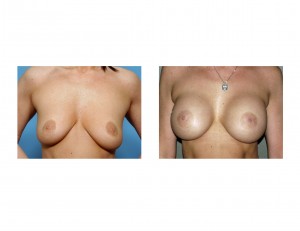Background: The breasts are well known to be changing structures throughout a women’s lifetime. While gravity does have its own effect over time, the impact of pregnancies is usually more significant. While the increase in size is a well known effect of pregnancy on the breast, less appreciated is the actual loss of breast tissue after delivery. Known as postpartum involution, breast tissue shrinks or loses volume compared to what existed before pregnancy.
It is the loss of volume that actually causes the greatest amount of visible change in breast shape after pregnancy. The breast may sag but it is as much as the loss of support due to less internal volume that it is due to stretched out skin. When loss of breast volume is significant but the overlying skin quality is good (not stretched out), the breast will appear deflated as the nipple position stays above the lower breast fold. If the breast skin becomes too stretched out during pregnancy, skin will sag over the fold and may carry the nipple with it after delivery.
How well implants will help restore a woman’s breast after pregnancy is significantly influenced by whether the breast is ‘deflated’ or ‘saggy’. In the deflated breast, an implant will do a remarkable job of restoring breast size and shape or even making it better than it was before. But in the saggy breast, an implant alone is insufficient as increased volume will not lift the nipple back up above the lower breast fold.
Case Study: This 29 year-old female wanted implants to restore her breasts after having had two children. Between the pregnancy and breast feeding, she had lost much of her breast volume and round breast shape. Her breasts essentially looked like deflated sacs of skin. But despite this degree of involution, her nipple-areolar complexes remained above the lower breast fold with only a small amount of lower pole skin hanging over it. (pseudoptosis) Her breasts were much more deflated than saggy.



In the postpartum involuted breast, a combined lift with an implant is frequently needed due to the sag of the breast tissue. If the nipple is at or below the lower breast fold, a breast lift is unavoidable. But in the truly deflated breast, implant augmentation alone produces a very satisfactory result.
Case Highlights:
1) Pregnancy frequently causes loss of breast tissue, a process known as postpartum involution. What happens to the overlying breast skin is variable and determines what the post-pregnancy breast looks like. (deflated vs saggy)
2) Augmentation of the deflated breast is done with implants, preferably using the new high-strength gel material (gummy bears) which gives a very natural feel.
3) For the women who has lost breast tissue from pregnancy (involution), an adequate result from only placing breast implants depends on the position of the nipple to the lower breast fold.
Dr. Barry Eppley
Indianapolis,Indiana


